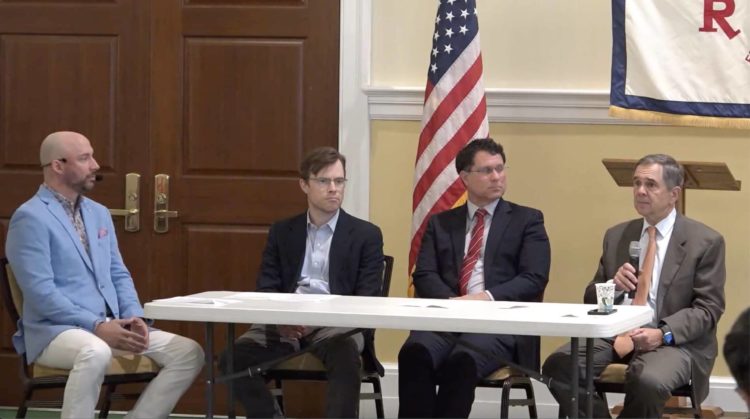
By The Retired Men’s Association of Greenwich
At the June 21 meeting of the Greenwich Retired Men’s Association, Spike Lipschutz introduced today’s panelists, who addressed the diagnosis and treatment of prostate cancer. Dr. Jeff Puglisi, internist at Greenwich Hospital, served as facilitator, with three physicians from Yale School of Medicine/Greenwich Hospital serving as panelists: Bruce McGibbon, radiation oncologist, Daniel Petrylak, oncologist, and Michael Karellas, urologist.
Dr. Puglisi began by presenting some data regarding prostate cancer. About 13% of men will develop prostate cancer. It is expected that, in 2023, there will be about 288,000 new cases of prostate cancer diagnosed in the United States, and about 35,000 men will die of this disease.
Early detection has a large impact on the outcome of prostate cancer, with cases that are caught late having about triple the fatality rate of those caught early.
A fundamental issue regarding the diagnosis and treatment of prostate cancer is balancing the harm of the disease against the harm of the treatment. While some prostate cancers are aggressive and life-threatening, others are slow-developing and unlikely to be fatal. Simply put, the concern should be with cancers that one might “die from” rather than with those that one might “die with.” Given that some prostate cancer treatments can have serious adverse side effects (such as erectile dysfunction and continence problems) the panelists expressed wariness about treating cancers that are unlikely to pose a mortality or morbidity threat before the patient’s death from an unrelated cause.
For several decades, prostate specific antigen (PSA) levels have been a principal diagnostic tool for prostate cancer, with annual PSA tests being used for men over the age of about 50. The panelists noted, however, that while PSA is (essentially) specific to the prostate, it is not specific to cancer. A high PSA level might not be indicative of cancer. For this reason, several years ago a federal study cautioned against overreliance of PSA as a diagnostic tool, fearing the adverse side-effects of treatment of men who might have elevated PSA levels and yet are cancer-free. The panelists agree, however, that PSA remains a valuable adjunct when looked at in conjunction with other factors, such as family history, race, genetic data and symptoms. (The panelists note that digital rectal examinations are important, but they are only able to evaluate the side of the prostate that abuts the rectum.)
While the most reliable test for prostate cancer is a biopsy, a biopsy is not risk-free and is usually not advisable as a first-line test and until other data has been evaluated. (For example, a man with a high PSA and other indicators of possible prostate cancer may undergo an ultrasound or MRI to provide additional information and guidance before a biopsy is recommended.)
If prostate cancer is diagnosed, the next question is the biological aggressiveness of the particular tumor–traditionally measured by the “Gleason score.” This score is derived by.
assigning a score of from one to five to each of two biopsy specimens, based upon cell patterns. Thus, the maximum possible score would be 10. A biopsy sample that results in a score of six or less is indicative of a less aggressive tumor, probably not warranting aggressive treatment. Scores of eight or higher typically warrant intervention. A score of seven is considered “borderline,” and discussions with specialists are warranted.
The principal methods of treatment of prostate cancer are surgery, radiation and drugs. Surgery remains the most common form of treatment, although alternatives have been gaining ground. In prostate cancer surgery, there is reliable data to indicate that surgeons who have higher case numbers also have higher success rates and fewer adverse effects. For patients seeking a “second opinion,” second opinion review of the biopsy slides by an independent pathologist is often valuable.
Dr. McGibbon discussed the various considerations and regimens for radiation therapy as an alternative to surgery. The “typical” course of treatment involves 28 sessions of fifteen minutes, administered for five days per week. For a very large prostate, more sessions (with lower doses per session) might be required. Treatment regimens are individualized, and are typically complemented by hormone therapy from four to 18 months after radiation.
Chemotherapy for prostate cancer is relatively new. Dr. Petrylak noted that a lot of progress is being made in this area and that Yale-New Haven is at the vanguard in research in this area.
The panelists noted the important of a team approach in helping patients to navigate the diagnostic and therapeutic decision-making process–as illustrated by the specialty make-up of the panel itself.
Dr. Puglisi opined (during the Q and A session) that, in 15 years or so, we might be reading that “COVID helped to cure cancer”–meaning that the intensive work on vaccines
may have contributed to our being able to weaponize our own immune systems in the treatment of cancer.
To see the full presentation, go to http://greenwichrma.org cursor to “Speakers” and click on “Speaker Videos”.
Note: The views expressed in these presentations are those of the speakers. They are not intended to represent the views of the RMA or its members.
RMA speaker presentations are presented as a community service at no cost to in-person or Zoom attendees, regardless of gender. The RMA urges all eligible individuals to consider becoming a member of our great organization, and thereby enjoy all the available fellowship, volunteer, and community service opportunities which the RMA offers to its members. For more information, go to https://greenwichrma.org/, or contact our membership chairman (mailto: members@greenwichrma.org).




